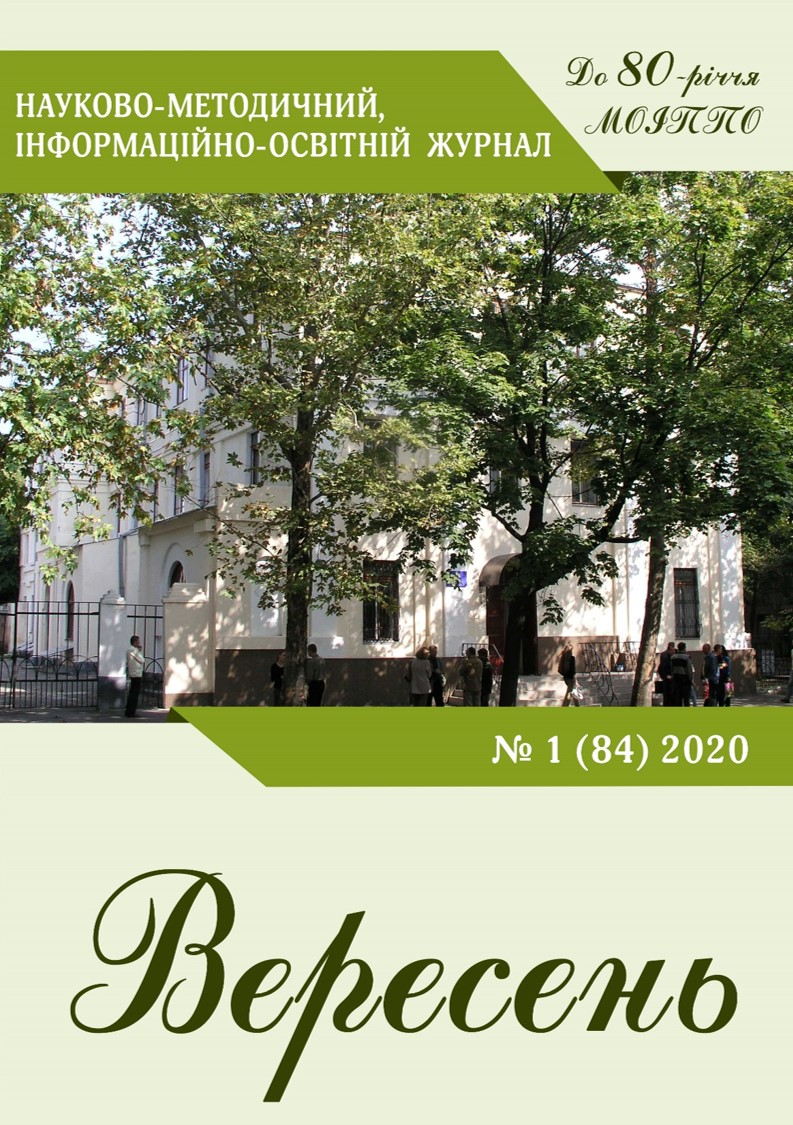PERSONALIZED ACMEOLOGICAL PERSONALITY DEVELOPMENTAL MODEL OF THE NEW UKRAINIAN SCHOOL'S SUBJECTS ACCORDING TO THE KOSTIANTYN USHYNSKYI’S DIDACTIC SYSTEM
Keywords:
Keywords: acmeological model, child-centrism, didactic system, Kostiantyn Ushynskyi, logical semiotic model, New Ukrainian School, pedagogical axiomatic, teacher-centrism, triad, trinity.Abstract
The author of the article has analyzed the educational documents, concepts, guidelines and the Kostiantyn Ushynskyi's legacy. Personalized developmental models for the subjects of the New Ukrainian School are offered. For this purpose, the didactic multidimensional technology of pedagogical design was used. Along with this, we have identified a number of new concepts that make it possible to visualize models. Among such tools there are logical semiotic models (LSM) based on the triad philosophy. Working versions of definitions for the «triad» concept are proposed.
Logical semiotic models are built on the hierarchical trinity principles. The significance of such models is obvious. They ensure the integrity of views on phenomena, concepts, reality etc. This approach is considered to be a new type of systematization and it is distinguished by its openness.
The analysis of the New Ukrainian School’s concepts and Kostiantyn Ushynsky's legacy were conducted from the standpoint of pedagogical axiomatics. A number of axioms from the above have become unifying for the logical semiotic models development. The personalized developmental model of the New Ukrainian School’s subjects includes the following components: personality-oriented educational landscape, subjects of educational institution and Me-creator. This model demonstrates the need to implement human / child / teacher-centered educational process with the appropriate infrastructure involvement.
Kostiantyn Ushynskyi’s didactic system is built on a psychological foundation and we build on the triad model as well. The components of the logical-semiotic model are interaction, which provide the internal course of the education, and movement (action) as a motivational component of the triad.
The proposed acmeological models demonstrate the need to implement human / child / teacher-centered educational process, taking into account the relevant infrastructure. The well-thought-out infrastructure of the educational institution will ensure the creation of the person-oriented educational environment. Such educational environment should be wisely organized and built as a noosphere. It must take into account the kids’ natural and social background, the subjects’ connections, considering universal and spiritual laws. This approach will implement concepts from the New Ukrainian School and Kostiantyn Ushynskyi’s legacy and each one can feel oneself comfortable, cozy, safe, acting and creating in the name of their own future.
Didactic multidimensional technology of pedagogical design is very productive and it might help to develop other logical and semiotic models with well-known teachers’ techniques.
References
Referenses
Kontseptualni zasady reformuvannia serednoi shkoly «Nova ukrainska shkola» (2016). [Conceptual principles of reforming the secondary school «New Ukrainian School»]. – Retrieved from: https://mon.gov.ua/storage/app/media/zagalna% 20serednya/nova-ukrainska-shkola-compressed.pdf. [ukr].
Lavrent'ev, G. V., Lavrent'eva, N. B., & Neudahina, N. A. (2004). Obuchajushhie tehnologii v professional'noj podgotovke specialistov [Teaching technologies in the professional training of specialists]. Barnaul: Izd-vo Alt. un-ta [rus].
Monahov, V. M. (2001). Pedagogicheskoe proektirovanie – sovremennyj instrumentarij didakticheskih issledovanij [Pedagogical design is a modern toolkit of didactic research]. Shkol'nye tehnologii, 5, 75–89 [rus].
Ostapenko, A. A. (2007). Modelirovanie mnogomernoj pedagogicheskoj real'nosti: teorija i tehnologii. [Modeling of multidimensional pedagogical reality: theory and technology]. M.: Narodnoe obrazovanie. [rus].
Pro osvitu. Zakon Ukrainy (2017). [Law of Ukraine «On Education»]. Vidomosti Verkhovnoi Rady (VVR), 38-39, 380. Retrieved from: https://zakon.rada.gov.ua/laws/show/2145-19 [ukr].
Shuliar, V. I. (2006 a). Planuvannia literaturnoi osvity shkoliariv: tekhnolohichna kontseptsiia: praktyko-oriientovana monohrafiia [Planning of literary education of schoolchildren: technological concept: practice-oriented monograph]. Prof. N. Voloshin (Ed.). K.: Vydavnytstvo «Ch»[ukr].
Shuliar, V. I. (2012). Suchasnyi urok ukrainskoi literatury: teoriia, metodyka, tekhnolohiia: monohrafiia [Modern lesson of Ukrainian literature: theory, methods, technology: monograph]. Mykolaiv: Ilion [ukr].
Shuliar, V. I. (2006 b). Uchen-chytach i vchytel-fasylitator v umovakh 12-richnoi shkoly: nauk.-metod. posib [Student-reader and teacher-facilitator in a 12-year school: scientific method. way]. V. I. Shuliar, N. M. Ohrenych. Mykolaiv: Vydavets Hanna Hinkul [ukr].
Shuliar, V. (2018). Uchitel' Vasil' Suhomlins'kij: uroki na zavtra (vid shkoly Vasylia Sukhomlynskoho do Novoi ukrainskoi shkoly): praktyko-oriientovana monohrafiia [Teacher Vasyl Sukhomlynsky: lessons for tomorrow (from the school of Vasyl Sukhomlynsky to the New Ukrainian school): practice-oriented monograph] [ukr].
Ukraina 2030. Ukrainskyi instytut maibutnoho [Ukrainian Institute of the Future]. Kyiv, kviten 2019 [ukr].
Ushynskyi, K. D., (1983). Vybrani pedahohichni tvory: u 2 t. [Selected Pedagogical works in 2 volumes]. Kyiv: Rad. shkola [ukr].
Ushynskyi, K. D. (1954). Tvory: u 6 t. [Works: in 6 volumes]. K.: Rad. shkola [ukr].




